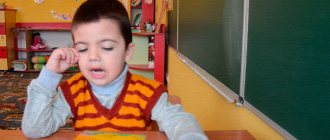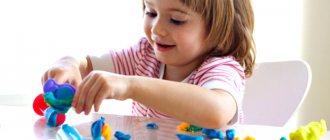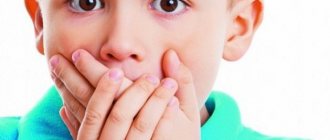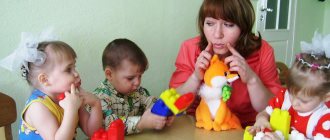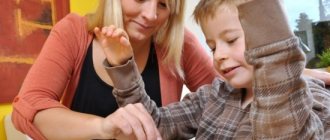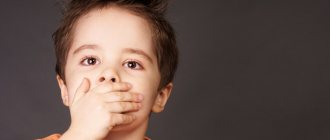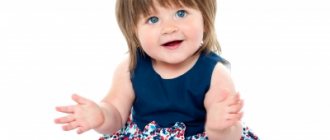Pedagogical characteristics for a child to be submitted to the PMPK commission
Pedagogical characteristics for a preschool child.
Date of completion:
1.General information about the child
: FULL NAME. baby
Date of Birth
MKDOU "" group No. group type _general developmental _ Duration of stay in this MKDOU: ________
Features of the visit_______________________________________________________________________________
Assessment of a child’s adaptation in a group: average degree of adaptation.
2. Family characteristics:
- FULL NAME. parents, year of birth, place of work
________
— Family composition: single-parent, large family
— Family type: dysfunctional
— Who is involved in raising the child: mother, grandmother
— The nature of the relationship with the child: connivance
3.Features of the child’s appearance:
the appearance is untidy, there is an unpleasant smell from the clothes, the child does not slouch, the gait is smooth and swift, and he mainly moves around the group at a run.
4. Sleep, appetite:
restless sleep for a long time, selective appetite.
5. Somatic health:
Health group III, chronic disease present (), rarely misses kindergarten due to illness, does not suffer from enuresis or encopresis.
6.Features of the motor sphere:
Gross motor skills:
Coordination, tempo, rhythm of movement are slightly impaired, motor clumsiness, movements according to verbal instructions are performed with difficulty, or are not performed.
Manual motor skills
: insufficient fine motor skills (cannot cope with buttons, zippers, there are difficulties in using scissors, when working with plasticine, with pencils), the range of movements is incomplete, the pace is slow, switching is inaccurate, coordination - minor impairments.
Leading hand:
the leading hand is not formed.
4. The child’s knowledge by sections of the preschool education program
(educational areas)
Speech development
The sound side of speech: sound pronunciation: not within the age norm, the phonetic structure of speech is not sufficiently formed, not all sounds are pronounced correctly in isolation, phonemic defects in sound pronunciation (omission, distortion), phonological defects (substitutions, confusion); Features of phonemic hearing: impaired.
Vocabulary: severely limited; does not use adjectives or prepositions in speech; minor defects in the syllabic structure of a word.
Coherent speech: speech is slurred, does not correspond to age norms, requires development; the nature of the sentences is simple, the ability to answer adult questions is monosyllabic. Does not know how to construct sentences for demonstrations, actions based on pictures, compose a story based on an object, plot picture, or a series of plot pictures; cannot retell a fairy tale, compose a story, recite a poem; does not know how to participate in dialogue; instead of answering the question, he repeats the adult’s (educator’s) question without answering it. Does not always understand the content of the work (story, fairy tale, poem).
Social and communicative development
He is not able to behave in accordance with the norms, has no idea about safe behavior in everyday life (climbs on shelves, cabinets, racks, hides under the table, in the closet). He often comes home with bruises, burns, and bumps on his head. While walking, he hangs on tree branches and jumps from dangerous heights. Psychologically not resistant to failure: can throw chairs, climb under the table, kick the tabletop, throw objects at children. Hysterics happen every day - he cannot move from one routine moment to another (after second breakfast he needs to go for a walk, but the child does not get dressed, often does not go outside with all the children, remains with the assistant teacher in the group). Does not follow adult instructions. Doesn't always achieve its goal.
Cognitive development
The stock of knowledge and ideas about the surrounding reality, nature, family and oneself do not correspond to the age norm.
He only says his name, cannot say his age, mother's name, or grandmother's name.
Doesn't know geometric shapes, can't name them, confuses them (calls a circle a ball, a square a cube).
The concepts: high-low, narrow-wide, long-short have not been formed. Well versed in concepts: big-small. Names objects by size with the help of the teacher (largest, smallest and smallest).
Cannot arrange pictures in order according to a familiar plot (Turnip, teremok).
Counting skill - counting to three.
Doesn't fold a pyramid of five rings. Assembles puzzles of 4-6 parts.
The student does not know how to navigate on a sheet of paper.
Has difficulty showing primary colors, can group objects by color, but does not name them and confuses them.
Does not recognize objects by a certain characteristic, does not combine them into groups based on a selected characteristic.
Doesn't know animals, gets confused (for example, calls a donkey a horse, a goat a sheep). He doesn’t know how to name them or show what sounds they make. Does not divide into wild and domestic, does not name the cubs.
Does not know how to navigate contrasting parts of the day: day-night, morning-evening. The child does not determine or express in words the location of an object in relation to other objects.
Artistic and aesthetic development
Shows interest in productive activities. When working with a brush or pencils, he experiences difficulties because he confuses his hands (the leading hand is not formed) and does not hold it correctly. The drawing cannot convey the image. Does not correlate objects by size, height, location, relative to each other. He has been drawing something of his own for a long time. Doesn't do the job neatly. Has difficulty working with scissors (spreads the scissors with both hands to cut paper). When working with glue, he smears the part without respecting the boundaries, and may lick the glue.
During modeling classes, he cannot create objects of a given shape. He randomly pinches off small pieces of plasticine and mixes them together, or spreads them on oilcloth; to get results in his work, the instructions must be repeated several times and his actions monitored.
Enjoys playing with building materials. It is not always possible to create a given building - the help of a teacher is required. Enjoys participating in team design work.
The skill and interest in listening to musical and artistic works has not been developed; he does not recognize or sing songs. He is absently present during music lessons. Depending on the mood, she can dance together with a child.
The pace of work is low, the child’s performance is low. The boy is not assiduous, is often distracted, does not always complete the work he starts, and does not show interest in the final result of the activity.
Physical development
Shows no interest in physical education classes, refuses to comply with the requirements and rules of the instructor, can run chaotically around the hall, and does not participate in outdoor games. The level of physical development does not correspond to age.
5. Attitude to classes
: does not take part in classes on speech and cognitive development, even if invited individually, does not lend itself to persuasion. Occasionally he can come to class himself, but participation lasts no more than 3-4 minutes, all this time he plays, spins in his chair, interferes with the children, distracts them. In classes on artistic and aesthetic development (appliqué, modeling, drawing), he is mainly present, but is not able to control his activities; the help of a teacher is needed to get the final result. Doesn't get things done, gets exhausted quickly, works slowly.
He does not immediately accept verbal help, does not perceive it, and sometimes does not understand what is required of him. Practical help is not always accepted; educational help is difficult to teach.
He does not try to overcome difficulties that arise in the process of activity, quits work, gets nervous, does not know how to turn to the teacher or children for help, and does not look for a way out on his own.
6. Characteristics of activity:
Self-care skills: can independently use toiletries, wash oneself, and wash hands.
He cannot dress, undress, or put on his shoes on his own, although he can. Can eat, drink, use a spoon (not held correctly), but not carefully, can drink from a plate, eat with his hands. Eating from someone else's plate. Doesn't know how to put away his things. Game activity
:
There is an interest in toys, there are favorite toys, he often brings them from home and does not part with them. He takes part in role-playing games extremely rarely, the nature of the game is primitive and there is no development of the plot (carries a car, rocks a doll, drinks from a toy cup). Cannot always perform all role-playing actions in relation to the toy. Does not accept the rules of the game, cannot wait for his turn, after which he throws the toys and runs away. During the game does not reflect one's own experience. Actions with toys are not focused on the properties and purpose of these toys (the designer does not use it as a building material, but walks on it, throws it, and can draw on the toys).
7.
Features of communication:
Prefers to be alone, often secludes himself. When communicating with children, he is often aggressive, he can hit or throw some object at the child. Takes toys, does not know how to support the game. Breaks children's buildings and sometimes interferes with children's play. Doesn't accept the rules of the game. When communicating with adults, he is disobedient, stubborn, and hysterical. Cannot turn to an adult, extremely rarely fulfills an adult’s requests.
8. Personality characteristics
:
The mood easily changes for minor reasons; emotions, especially negative ones, are expressed with great noise.
There is an attachment to one soft toy - a dog; he does not go to bed without it. Chews pencils. In classes on artistic and aesthetic development he shows activity and enthusiasm, but in other types of activities he shows passivity. There is no initiative. Restless behavior
9. Additional information:
The child’s parents are not interested in his successes and do not listen to the recommendations of the teachers.
Date of: _____________________________________
Teachers: _____________________________________
Head of MKDOU "": _____________________________________
1.
In the
“General information about the child”
, you should indicate where he came from (from a family, from another MBDOU), whether there were long breaks in attending a preschool institution, and for what reasons. Assessment of the child’s adaptation in the group: high (mild), medium, severe degree of adaptation.
2.
In the section “
Features of the child’s appearance”,
briefly note: posture, gait, gestures, facial expressions, presence of drooling, etc.
3. Sleep characteristics
: presence of daytime sleep, calm, restless.
Appetite is good, bad, selective. 4.
In the section
“ The child’s knowledge by sections of the program,”
describe the child’s knowledge and what difficulties he experiences in learning.
Cognitive development:
A stock of general information about the environment: names (does not) name one’s name, age, parents’ names, home address, seasons are indicated by a word (difficult); names the signs of the seasons (difficult) does not know; knowledge about flora and fauna corresponds to program requirements, but is insufficient.
Formation of elementary mathematical concepts.
Quantity and counting.
Color perception: no idea of color, distinguishes colors, recognizes and names primary colors,
groups objects by color.
Perception of shape: has no idea about shape, groups geometric shapes, identifies geometric shapes by word, distinguishes and names geometric shapes (flat and three-dimensional), correlates the shape of an object with a geometric shape, groups objects by shape.
Temporal representations: temporal representations are not formed, he orients himself in the time of day, consistently names the days of the week, knows the names of the months of the year, determines and names the time of year.
Spatial representations: spatial representations are not formed, performs movement in the indicated direction according to verbal instructions, determines the position in space in relation to oneself (left, right, in front, behind), uses words in speech that determine the position of an object in space.
Artistic and aesthetic development:
Formation of artistic skills and musical development by age. knows how to properly hold a pencil, brush, scissors, use a ruler and template, is able to appreciate the beauty of works of fine musical art, and is capable of visual creativity.
Speech development
Dictionary: indicate: the norm (the vocabulary is sufficient, corresponds to the age norm), within the limits of everyday life, sharply limited; to what extent: sharply limited, somewhat limited, without visible restrictions; due to what words (parts of speech) it is limited;.
Coherent speech: corresponds to the age norm, in the formative stage, requires further development, not formed; the nature of sentences (simple, complex, common, less common, not common, incomplete), the ability to answer adults’ questions in monosyllables or in complete phrases, the ability to construct sentences based on demonstrations, actions based on a picture, the ability to compose a story based on an object, a plot picture, a series of plot pictures, retell a fairy tale, story, recite a poem; possibility of dialogue.
Social and communicative development:
wants to grow up; able to behave in accordance with norms; has an idea of safe behavior in everyday life (dangerous objects), nature, on the street, with strangers; psychologically resistant to failure, able to persistently achieve goals; plays story-based games with continuation; follows adult instructions; has a developed readiness for school.
Physical development:
level of physical development, compliance or non-compliance with age.
5.
Attitude to classes:
unable to control one’s activities, does not complete the task, interferes with the teacher and children, quickly exhausts oneself, works slowly and unevenly, the pace of activity is fast, but the activity is “chaotic and stupid”); does he accept help and what kind: (verbal, practical, stimulating, guiding, organizing, teaching); how to overcome difficulties that arise in the process of activity: (not) strives to overcome, quits work, spies on others, cries, worries and is nervous, turns to the teacher, children for help, independently looks for a way out.
6. Characteristics of activity:
Self-care skills
: can he independently use toiletries, wash his face, wash his hands, comb his hair;
can he dress, undress, put on his shoes, fasten his shoes, tie and untie his shoelaces independently; can he eat, drink, use a spoon and fork independently; can he clean his things and bed? Game activity
: indifference or interest in toys, favorite games, does he understand the rules of the game, does he follow them, does he make changes to the content of the game, accessibility of an imaginary situation, role in a collective game, behavior in a conflict situation, does he reflect his experience in the game, ( not) knows how to support the game.
7. Features of communication:
no difficulties; does not know how to support the game; prefers to be alone; cries, has little contact with adults and children; conflicted; other.
8. Personality characteristics
:
adequacy of emotional reactions, activity or passivity in various types of activities, presence or absence of initiative, compliance, irritability, passivity in the process of communicating with children and adults; shyness, capriciousness, tearfulness, apathy, obsession, timidity; prevailing mood; behavior: calm, adequate to the situation, restless; moral qualities: adequacy of relationships with relatives, peers, other people, a sense of affection, love, kindness, a tendency to help or harm, to offend others, aggressiveness, deceit, etc., the ability to obey the demands of adults, accuracy, cleanliness, emotional adequacy reactions to approval and blame.
9. In the section “Additional features of child development
“You can note what type of activity you have aptitude for and the manifestation of creative abilities. Causes of developmental delay. Positive and negative qualities of a child.
Organizational aspects
The document is prepared with the participation of a psychologist, speech therapist and teacher. A ready-made description of a kindergarten student is provided for:
Free legal consultation
We will answer your question in 5 minutes!
Free legal consultation We will answer your question in 5 minutes!
Call: 8 800 511-39-66
Ask a Question
- Admission to school.
- Solutions to legal issues.
- Consultations with a psychiatrist.
- Commissions for transfer to a speech therapy group or specialized educational institution.
- Children with disabilities who attend kindergarten.
- Guardianship and trusteeship authorities.
This is also important to know:
What is a deposit, what is it for and how to arrange its transfer
The pedagogical characteristics of a preschool educational institution student is an official document that is invalid without the signature of all persons filling out the form. The seal and signature of the head of the institution is also required.

